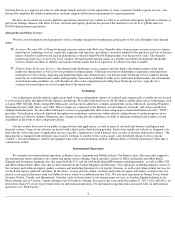Enom 2013 Annual Report Download - page 16
Download and view the complete annual report
Please find page 16 of the 2013 Enom annual report below. You can navigate through the pages in the report by either clicking on the pages listed below, or by using the keyword search tool below to find specific information within the annual report.
We base some of our capital allocation decisions on our analysis of the predicted internal rate of return on our capitalized content. If the
estimates and assumptions we use in calculating the internal rate of return on capitalized content are inaccurate, our capital may be
inefficiently allocated and our growth rate and financial results could be adversely affected.
We invest in capitalized content based on our calculation of the internal rate of return on previously published content cohorts for which
we believe we have sufficient data. For purposes of these calculations, a content cohort is typically defined as all of the capitalized content we
publish in a particular quarter. We calculate the internal rate of return on a cohort of content as the annual discount rate that, when applied to the
advertising revenue generated from the cohort over a period of time, less certain direct ongoing costs, produces an amount equal to the initial
investment in that cohort. Our calculations are based on certain material estimates and assumptions, including estimates about the costs to create
capitalized content and the revenue allocated to that content. We also make estimates regarding when revenue for each cohort will be received.
Our internal rate of return calculations are highly dependent on the timing of this revenue, with revenue earned earlier resulting in greater
internal rates of return than the same amount of revenue earned in subsequent periods. If our estimates and calculations do not accurately reflect
the costs or revenue associated with our capitalized content, the actual internal rate of return of a cohort may be more or less than our estimated
internal rate of return for such cohort. In such an event, we may inefficiently allocate capital and our growth rate and financial results could be
adversely affected.
We face significant competition to our content and media service offering, which we expect will continue to intensify, and we may not be able
to maintain or improve our competitive position or market share.
We operate in highly competitive and still developing markets. We compete for advertisers and customers on the basis of a number of
factors including return on marketing expenditures, price of our offerings, including our newer product and services offerings as part of our
commerce initiatives, and the ability to delive r large volumes or precise types of customer traffic. This competition could make it more difficult
for us to provide value to our consumers, our advertisers and our freelance creative professionals, including artists who submit original works to
Society6, and result in increased pricing pressure, reduced profit margins, increased sales and marketing expenses, decreased website traffic and
failure to increase, or the loss of, market share, any of which would likely seriously harm our business, financial condition and results of
operations. There can be no assurance that we will be able to compete successfully against current or future competitors.
We face intense competition to our content and media service offering from a wide range of competitors. Our current principal
competitors include:
We may be subject to increased competition in the future if any of these competitors devote increased resources to more directly address
the online market for the professional creation of commercially valuable content. For example, if Google chose to compete more directly with
us, we may face the prospect of the loss of business or other adverse financial consequences given that Google possesses a significantly greater
consumer base, financial resources, distribution channels and patent portfolio. In additi on, should Google decide to directly compete with us in
areas such as content creation, it may decide for competitive reasons to terminate or not renew our commercial agreements and, in such an event,
we may experience a rapid decline in our revenue from the loss of our source
14
1
Online Marketing and Media Companies . We compete with other Internet marketing and media companies, such as AOL, IAC and
various startup companies as well as leading online media companies such as Yahoo!, for online marketing budgets. Most of these
competitors compete with us across several areas of consumer interest, such as do-it-yourself, health, home and garden, arts and
crafts, beauty and fashion, golf, outdoors and humor.
1
Social Media Outlets . We compete with social media outlets such as Facebook, Twitter and Google+, where brands and advertisers
are focusing a significant portion of their online advertising spend in order to connect with their customers.
1
Integrated Social Media Applications
. We compete with various software technology competitors, such as Jive Software, in the
integrated social media space where we offer our social media applications.
1
Specialized and Enthusiast Websites . We compete with companies that provide specialized consumer information websites,
particularly in the do-it-
yourself, health, home and garden, arts and crafts, beauty and fashion, golf, outdoors and humor categories, as
well as enthusiast websites in specific categories, including message boards, blogs and other enthusiast websites maintained by
individuals and other Internet companies.
1
Distributed Content Creation Platforms
. We compete with companies that employ a content creation model with aspects similar to
our platform, such as the use of freelance creative professionals, including for the creation of paid content service offerings.
1
Specialty e-Commerce Marketplaces . We compete with companies that offer specialty products that are produced and shipped based
on a print-on-demand model, such as user or artist generated art designs printed on t-shirts, art prints, mobile accessories and other
products.
























